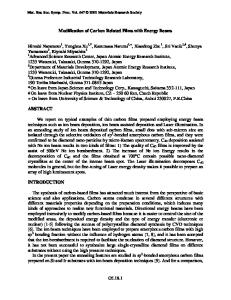Biocompatible Carbon Dots with Diverse Surface Modification
- PDF / 820,487 Bytes
- 7 Pages / 612 x 792 pts (letter) Page_size
- 22 Downloads / 385 Views
Advances:
Email alerts: Click here Subscriptions: Click here Commercial reprints: Click here Terms of use : Click here
Biocompatible Carbon Dots with Diverse Surface Modication Jilong Wang, Siheng Su and Jingjing Qiu MRS Advances / FirstView Article / June 2016, pp 1 - 6 DOI: 10.1557/adv.2015.36, Published online: 28 December 2015
Link to this article: http://journals.cambridge.org/abstract_S2059852115000365 How to cite this article: Jilong Wang, Siheng Su and Jingjing Qiu Biocompatible Carbon Dots with Diverse Surface Modication. MRS Advances, Available on CJO 2015 doi:10.1557/adv.2015.36 Request Permissions : Click here
Downloaded from http://journals.cambridge.org/ADV, IP address: 128.255.6.125 on 08 Jun 2016
MRS Advances © 2015 Materials Research Society DOI: 10.1557/adv.2015.36
Biocompatible Carbon Dots with Diverse Surface Modification Jilong Wang1, Siheng Su1, and Jingjing Qiu1,* 1 Department of Mechanical Engineering, Texas Tech University, 2500 Broadway, P.O. Box 43061, Lubbock, TX 79409, U.S.A. * E-mail: [email protected]; Phone: 806.742.3563; Fax: 506.742.3540. ABSTRACT In this paper, hydrothermal method has been employed to synthesize oxygen-modified carbon dots (O-CDs) from citric acid and nitrogen and sulfur modified carbon dots (N,S-CDs) from citric acid and cysteine. Both as-prepared carbon dots achieve naked-eye observable bluegreen luminescence. Fourier transform infrared spectroscopy (FTIR) and X-ray photoelectron spectroscopy (XPS) are used to exhibit the chemical composition of carbon dots. The structure and size of both carbon dots are similar via transmission electron microscopy (TEM) and dynamic light scattering (DLS), which indicates that the function of size effect can be neglected in this study. Fluorescence properties, UV-vis absorption and solubility are systemically studied to investigate the influence of surface modification. The N,S-CDs show high quantum yield and excitation independent photoluminescence, however, the O-CDs present low quantum yield and excitation dependent photoluminescence, and both carbon dots achieve strong photo-stability. The cytotoxicity of carbon dots is also performed on U87-MG brain tumor cells, which shows that both carbon dots process good biocompatibility and low toxicity in live cell. The bright cellular imaging photos indicate that both carbon dots have great potential to serve as high quality optical imaging probes. INTRODUCTION Carbon dots (CDs), like graphene quantum dots (GQDs)[1] and graphene oxide (GO)[2], have received tremendous attention due to their excellent electronic and optical property, biocompatibility and low toxicity since they were first found in 2008[3]. In contrast to other fluorescent materials, carbon-based fluorescent materials show better photostability against photobleaching and blinking[4]. However, the quantum yield of CDs, similar with GQDs, is very low[5], which limit applications of CDs. In order to improve quantum yield of CDs, many method have been reported to obtain high quantum yield CDs[6]. Surface passivati
Data Loading...











